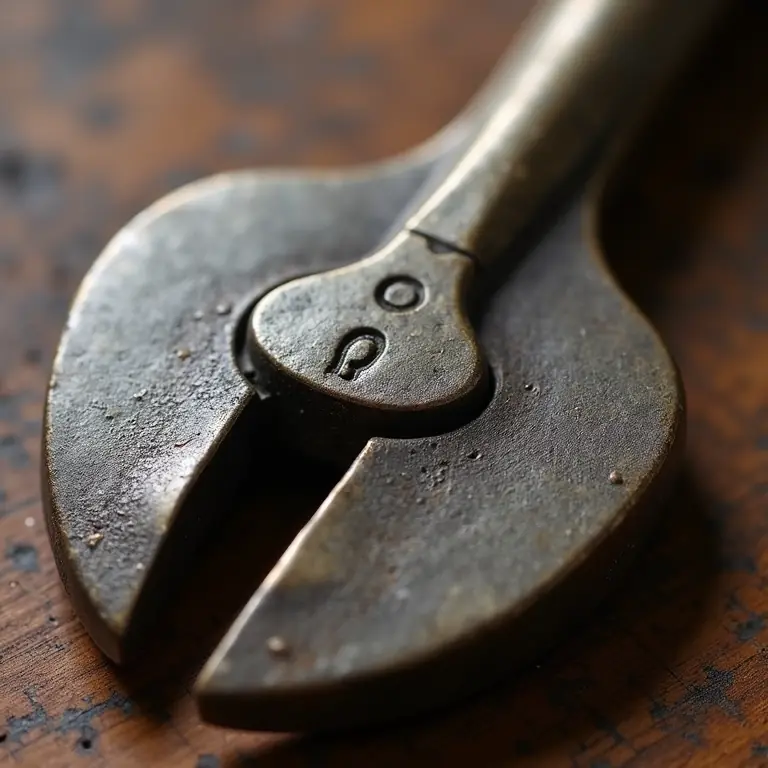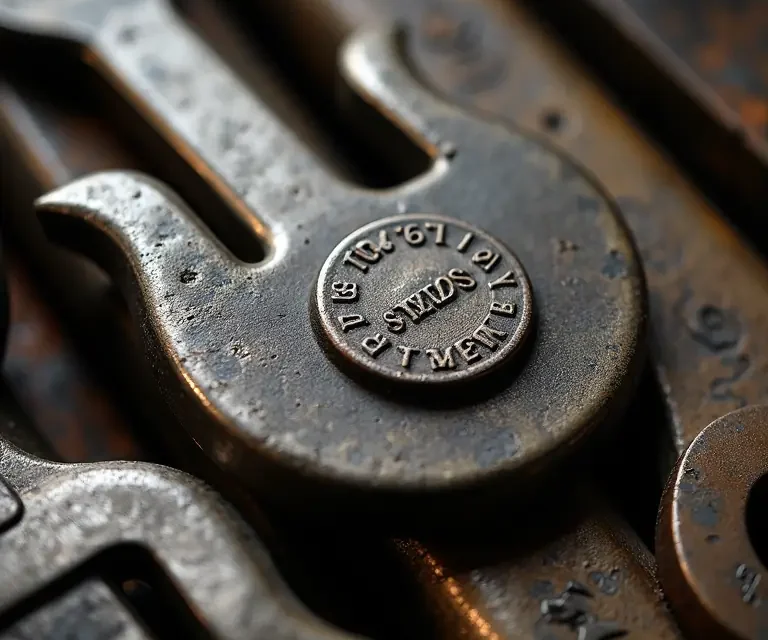Antique tools aren’t just beautiful objects; they are silent storytellers. Each scratch, dent, and, crucially, each marking on their surfaces holds a clue to their origins, their makers, and the world they inhabited. While seemingly arbitrary to the untrained eye, the markings found on antique tools – maker’s marks, hallmarks, and other identifying symbols – are surprisingly consistent in their logic and reveal a wealth of information to those who learn to decipher them. This article will delve into the fascinating world of antique tool markings, exploring their history, evolution, and what they can tell us about the craftsmanship and commerce of the past. We’ll cover everything from early, often individualistic markings to the more standardized systems that emerged with industrialization, and how to begin researching the provenance of your own antique finds.
A History Etched in Steel: The Evolution of Tool Markings
Before mass production, tools were largely the product of individual artisans. Early markings were often deeply personal – a blacksmith’s individual stamp, a silversmith’s unique hallmark, or simply a scratched initial indicating the tool’s owner. These weren’t necessarily intended as ‘branding’ in the modern sense, but rather as a declaration of responsibility, a signature of quality, or a way to reclaim a valuable item if lost. Think of it as a pre-industrial form of serial number, but imbued with the maker’s personality.
As trade guilds emerged, standards began to develop. Guilds often required members to register their marks, ensuring accountability and upholding the quality of work. This is where we see the beginnings of more formalized marking systems. For example, in England, the Worshipful Company of Blacksmiths had strict regulations regarding the marks used by its members. These early hallmarks weren’t just about identifying the maker; they also often indicated the metal’s purity and the location where the item was made.
The Industrial Revolution brought significant changes. The rise of factories and mass production necessitated more efficient and standardized marking techniques. Maker’s marks became more prominent, often incorporating the company’s name or logo. Serial numbers were introduced to track production and manage inventory. However, even with industrialization, many manufacturers retained elements of traditional craftsmanship in their markings, providing valuable clues about their history and evolution. It’s interesting to note parallels in other craft fields; consider the evolution of ink formulations, where traditional methods gradually gave way to scientific standardization, but traces of the old ways remain.
Decoding the Symbols: Common Types of Tool Markings
Maker’s Marks
These are the most common type of marking found on antique tools. They typically consist of the maker’s name, initials, or a distinctive symbol. The style of the mark can provide clues about the tool’s age and origin. Early maker’s marks were often hand-engraved and relatively simple. As technology advanced, marks became more elaborate, sometimes incorporating intricate designs or images. Identifying a maker’s mark is often the first step in researching a tool’s history. Resources like online databases (see “Resources for Research” below) and specialist books are invaluable for this purpose.
Hallmarks
Originally used primarily on silver and gold, hallmarks are a series of marks that indicate the metal’s purity, the maker’s mark, and the place of assay (where the metal was tested for purity). While less common on tools than maker’s marks, hallmarks can be found on tools made of precious metals or those incorporating silver or gold accents. They represent a level of quality control and provide precise information about the tool’s materials and origins.
Date Marks
Some tools bear date marks, either as part of the maker’s mark or as a separate stamp. These marks can indicate the year the tool was made, or the year it was registered with a guild or other organization. Date marks can be particularly helpful in narrowing down the tool’s age and placing it within a specific historical context.
Patent Marks
Tools incorporating patented designs often bear patent marks, indicating the year the patent was granted. These marks can provide valuable information about the tool’s innovation and the inventor who designed it. Patent marks can also be used to trace the evolution of tool design over time.
Inspection Marks
During periods of wartime or government contracts, tools might bear inspection marks indicating they met certain quality standards. These marks often take the form of initials or symbols representing the inspecting agency.
Ownership Marks
Beyond the marks applied by manufacturers, many tools bear the marks of their owners. These can range from simple initials scratched into the handle to more elaborate engravings. While these marks don’t reveal information about the tool’s origins, they can provide insights into its history and the people who used it.

The Regional Variations: A Global Tapestry of Marks
Tool markings aren’t uniform across the globe. Different countries and regions developed their own unique marking systems, reflecting their cultural traditions and industrial practices. For example, British tools often feature hallmarks and maker’s marks registered with the Assay Office, while American tools tend to rely more heavily on maker’s marks and patent numbers. German tools frequently display complex marks indicating the city of manufacture and the guild to which the maker belonged.
Understanding these regional variations is crucial for accurate identification. A mark that appears to be a maker’s mark in one country might be a different type of mark in another. Researching the specific marking practices of the country or region where the tool was likely made is essential.
Beyond Identification: What Tool Markings Tell Us
Tool markings aren’t just about identifying the maker or the date of manufacture. They offer a window into a broader historical context. They can reveal information about:
- Trade Routes: The presence of a maker’s mark from a distant location suggests the tool was traded or transported over long distances.
- Economic Conditions: The quality and complexity of the markings can reflect the economic prosperity of the time.
- Social Status: The tools used by different social classes often varied in quality and marking styles.
- Technological Innovations: Patent marks and design features can highlight technological advancements in toolmaking.
- Craftsmanship and Skill: The precision and artistry of the markings themselves can be a testament to the skill of the toolmaker.
The study of tool markings is, in essence, a form of material culture. It allows us to connect with the past in a tangible way and to appreciate the skill and ingenuity of the artisans who created these essential objects. It’s akin to studying the mechanics of vintage typewriters – a deep dive into a seemingly simple object reveals a complex history of innovation and design.
The Art of Observation: Developing Your ‘Eye’ for Tool Markings
Becoming proficient at deciphering tool markings requires practice and a keen eye for detail. Here are some tips for developing your skills:
- Start with the Basics: Familiarize yourself with common maker’s marks and hallmarks from your region.
- Pay Attention to Style: The font, engraving style, and overall design of the mark can provide clues about its age and origin.
- Consider the Tool Type: Different types of tools were often marked in different ways.
- Look for Multiple Marks: Tools may bear multiple marks, providing additional information.
- Document Your Findings: Keep a record of the marks you encounter and the tools on which they appear.
Like learning to read an old map – as detailed in the science of early map projections – it requires understanding the conventions and biases of the time.
Resources for Research
- Online Databases: Several websites specialize in identifying tool markings. Some popular resources include Tool Collector’s Club ([https://www.toolcollectorsclub.org/](https://www.toolcollectorsclub.org/)) and others dedicated to specific tool types (e.g., plane markings, chisel markings).
- Specialist Books: Numerous books document tool markings from different countries and periods.
- Museums and Historical Societies: Museums and historical societies often have collections of antique tools and resources for researching their history.
- Online Forums and Communities: Online forums and communities dedicated to antique tools can be a valuable source of information and expertise.
The Future of Tool Marking Research
The study of tool markings is an ongoing process. As new tools are discovered and new research is conducted, our understanding of these historical artifacts continues to evolve. Advances in digital imaging and database technology are making it easier to document and analyze tool markings, opening up new avenues for research. The application of AI and machine learning to image recognition could revolutionize the field, allowing for the automated identification of maker’s marks and hallmarks.
Furthermore, the increasing interest in preserving and restoring antique tools is driving a renewed appreciation for their history and craftsmanship. By understanding the stories etched into their surfaces, we can gain a deeper appreciation for the ingenuity and skill of the artisans who created them. It’s a similar dedication to detail found in the study of the history of penmanship, where even the smallest flourish can reveal a great deal about the writer and the era. And like the consistent principles underlying traditional herbal remedies, tool markings reveal a logic built on observation and practical application.
Finally, consider the precise measurements and techniques involved in woodworking itself. Here’s a helpful video demonstrating accurate marking and measuring:

